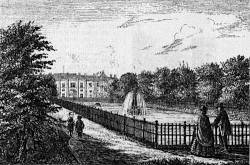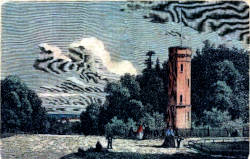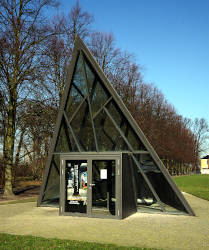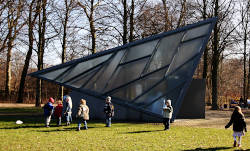Cisternerne
Useful Information



| Location: |
Søndermarken Park, Frederiksberg, Copenhagen.
(55.669462, 12.524940) |
| Open: |
During exhibitions Tue-Wed 11-18, Thu 11-20, Fri-Sun 11-18. During refurbishment closed. [2024] |
| Fee: |
Adults DKK 115, Children (18-27) DKK 90, Children (0-17) free, Students DKK 90. Museum Pass for all Frederiksberg Museums DKK 175. [2024] |
| Classification: |
 Water Supply Water Supply
|
| Light: |
 Incandescent Electric Light System Incandescent Electric Light System
|
| Dimension: | Ar=4,320 m², Twinter=4 °C, Tsummer=19 °C, H=100 %. |
| Guided tours: | D=45 min. V=100.000/a [2019] |
| Photography: | allowed, without flash and tripod |
| Accessibility: | no |
| Bibliography: | |
| Address: |
Cisternerne, Søndermarken, 2000 Frederiksberg, Tel: +45-30-73-80-32.
E-mail: Frederiksberg Museums, Andebakkesti 5, 2000 Frederiksberg, Tel: +45-69-13-80-90. E-mail: |
| As far as we know this information was accurate when it was published (see years in brackets), but may have changed since then. Please check rates and details directly with the companies in question if you need more recent info. |
|
History
| 1856 | begin of excavation of the cistern. |
| 1859 | cistern completed and integrated into the water supply. |
| 1933 | the function of the cisterns as the city’s drinking water reservoir is terminated. |
| 1981 | decommissioned. |
| 1996 | opened to the public as exhibition space during the year of European Capital of Culture. |
| 2001-2013 | used as a museum of modern glass art. |
| 2014 | reopened as a contemporary art gallery. |
Description



The abandoned Cisternerne under Copenhagen was transformed into an art gallery in 1996. It once held 16,000 m³ of drinking water, but the water supply was redesigned in 1933 and the cisterns were deactivated. This cistern was finally decommissioned in 1981. It was opened to the public in 1996, as part of Copenhagen’s year as the designated European City of Culture. This title is today known as European Capital of Culture and was created by Melina Mercouri, Greece, and Jack Lang, France, in 1985. The EU and the municipality organize a series of cultural events with a strong pan-European dimension during this year. The cistern was put to use as an exhibition space by the City of Frederiksberg and gallery owner Max Seidenfaden. Max Seidenfaden operated the cistern from 2001 to 2013 as a museum of modern glass art. After he closed his museum the site a part of the Frederiksbergmuseerne (Frederiksberg Museums) and was renovated as an exhibition space for contemporary art. It was reopened in 2014 as art gallery.
The cistern is open only during exhibitions, when an exhibition ends it is closed for some time, typically three months, for refurbishment. The gallery is visited by boats, which seat four persons and must be rowed by hand. As a result, the cistern is not wheelchair-accessible, and it is not possible to leave during the tour. Cisternerne is part of The Frederiksberg Museums, which also includes Storm P. Museet, Bakkehuset, Alhambra and Moesting’s Hus. If you plan to visit any other museum, we recommend the Museum Pass.
The cistern is located below Søndermarken park across from Frederiksberg Castle in Frederiksberg. Its construction was started in 1856 and took three years. This cistern as well as others solved the problems with the water supply, as it was possible to store water in wet periods of the year for use in drier periods. It also provided water for the fountains of the park.
The cistern is famous for the huge "speleothems" which can be found along the ceiling. The formation of stalactites and stalagmites from cement in concrete buildings is a common phenomenon. The dripstones in Cisternerne are beautiful, fragile and fascinating, and also the biggest which can be found in Denmark, so the site is sometimes dubbed the "only real dripstone cave in Denmark". They also call it an "urban dripstone cave", creative use of words but nevertheless nonsense. The dripstones grow much faster than in natural caves, because the chemical reaction differs. The limestone was roasted with clay to make cement, the cement was mixed with sand and water to make concrete. The calcium oxide in the concrete reacts with carbon dioxide to form limestone again. However, while the concrete becomes solid within hours or days, the complete transformation of the cement takes decades or even centuries. And so the concrete contains residuals of unreacted calcium oxide, which easily reacts with water in cracks, and when exposed to the air precipitates as limestone forming the stalactite. The same works with mortar between bricks. The growth rates in caves are about 1 cm in 100 years, but this concrete reaction is often much faster and may be between 1 cm and 10 cm per year. Because of those basic differences, the formations are called calthemites, and do not belong to the speleothems, because the speleo means natural caves, and so formations in non-natural spaces are not speleothems.
Quite interesting is the fact that the cistern is so close to the surface, that it is still influenced by the outside temperature. Unlike caves, which have the same temperature all year, the temperature fluctuates between 16 ºC in August and 4 ºC in February. In extreme years it may even exceed this range.
 Search DuckDuckGo for "Cisternerne Copenhagen"
Search DuckDuckGo for "Cisternerne Copenhagen" Google Earth Placemark
Google Earth Placemark Cisternerne - Wikipedia (visited: 20-OCT-2024)
Cisternerne - Wikipedia (visited: 20-OCT-2024) Cisternerne, official website (visited: 20-OCT-2024)
Cisternerne, official website (visited: 20-OCT-2024) Index
Index Topics
Topics Hierarchical
Hierarchical Countries
Countries Maps
Maps